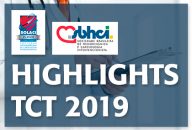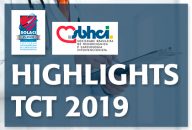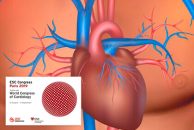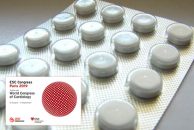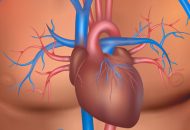The THEMIS study published this week in NEJM, tested chronic ticagrelor + aspirin in diabetic patients with stable coronary artery disease (CAD), but with no prior history of Myocardial infarction (MI) or stroke. The tempting hypothesis behind this study is that reducing ischemic events might increase bleeding events, and this calls for careful cost/benefit assessment. …
TCT 2019 | PCI in Stable CAD. Prior TAVR, with TAVR or Never?
Courtesy of SBHCI. This interesting study presented at TCT 2019 and simultaneously published in Am J Cardiol tells us PCI in stable coronary artery disease cannot lower risk in patients with severe aortic stenosis undergoing transcatheter aortic valve replacement (TAVR). Unless patients are symptomatic, most coronary artery lesions do not need revascularization according to researchers.…
TCT 2019 | MODEL U-SES: More Devices for High Risk of Bleeding and Short DAPT
Courtesy of SBHCI. This study tested the safety of dual antiplatelet therapy (DAPT) after only three months of bioresorbable polymer sirolimus DES implantation (Ultimaster). Secondary end point was following with P2Y12 inhibitor monotherapy after the first 3 months compared with aspirin. It included 1695 patients treated with sirolimus eluting Ultimaster receiving 3-month DAPT. After the…
ESC 2019 | CLARIFY: Symptoms Predict Risk Only in Patients with Prior MI
The 5-year follow up of patients with chronic stable angina (or as the guidelines currently call it “chronic coronary syndrome”) indicate the risk of cardiovascular death or non-fatal MI is quite low, but risk factor control is still fairly poor. This information comes from the CLARIFY study, presented at ESC 2019 and published simultaneously in…
ESC 2019 | AFIRE: Monotherapy with Rivaroxaban in Atrial Fibrillation and Stable CAD
In patients with atrial fibrillation and stable coronary artery disease who have not had revascularization procedures in the last 12 months, monotherapy with rivaroxaban seems the best treatment strategy compared to rivaroxaban plus antiplatelet antiaggregation. This is what resulted from the AFIRE study, presented during the ESC 2019 in Paris and published in NEJM. Monotherapy…
Amount of Baseline Ischemia in Patients with Multivessel Disease and Long-Term Progress
According to this recent analysis of the MASS II trial, which will soon be published in JAMA, baseline ischemia is not associated with events at 10 years in patients with chronic stable angina. The ischemic burden induced through exercise does not predict events or long-term ventricular function. Such data add some suspense to the results…
Nonobstructive Coronary Lesions and Ventricular Dysfunction
Many patients arrive to the cath lab for a diagnostic coronary angiography after an echo showing severe ventricular dysfunction, even in asymptomatic patients. In many occasions, their coronary arteries are normal, and in many others, we find coronary disease that is not enough to warrant such severe ventricular dysfunction. Patients with heart failure are frequently…
Asymptomatic Coronary Artery Disease, Silent Ischemia: A Cardiologist’s Headache
We need more evidence to guide us in the management of silent ischemia. Confirmed asymptomatic coronary artery disease is a problem for cardiologists, who lack enough evidence to guide a risk-benefit assessment that justifies revascularization. Revascularizing the outcome of a functional assessment may reduce the rates of death and infarction, or it may just be…
The “Ten Commandments” of Myocardial Revascularization According to Europe
The new European guidelines on myocardial revascularization were developed by a joint effort of the European Society of Cardiology (ESC) and the European Association of Cardiovascular Surgery (EACTS). These guidelines are intended to support clinical practice with pragmatic recommendations based on currently available evidence and on personal experience, whenever evidence is missing. Both coronary angioplasty…
The 10 most consulted articles at SOLACI during 2018
1- New High Blood Pressure Guidelines The wait is finally over: the high blood pressure guidelines that have been in the works for the past 3 years saw the light of day at the American Heart Association (AHA) 2017 Scientific Sessions. Read more 2- The 10 Commandments of ESC’s New STEMI Guidelines The authors…

